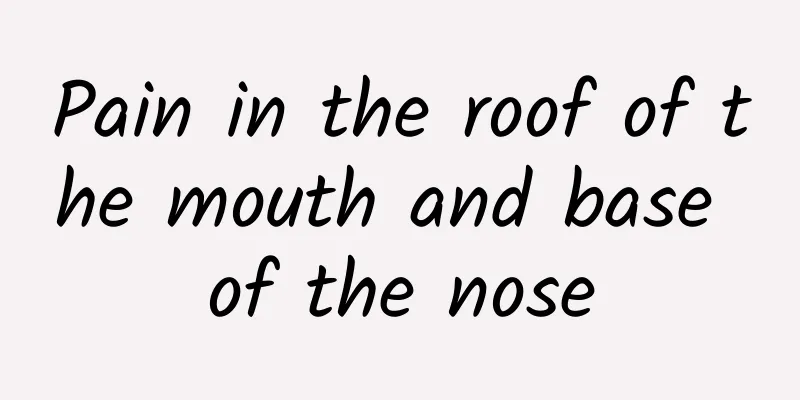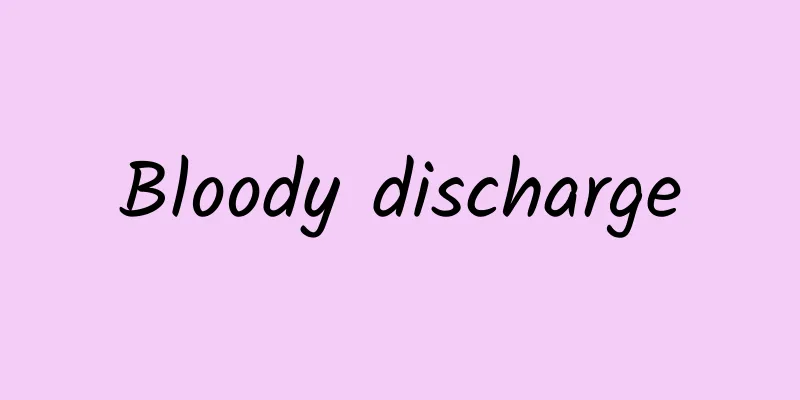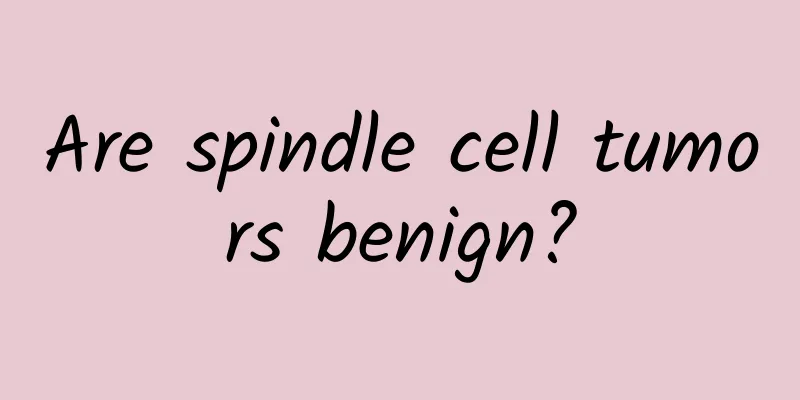Pain in the roof of the mouth and base of the nose

|
Many people may not know that the roof of the mouth and the nasal cavity are actually connected. If people's palate feels uncomfortable, the nasal cavity will also feel very uncomfortable. For example, when some people have pain in the roof of the mouth, they will also feel pain in the root of the nasal cavity. What is the reason for pain in the roof of the mouth and the root of the nasal cavity? What problem does it reflect? This may very well reflect a disease, so let's analyze it for you below. Sinusitis Causes Sinusitis can be divided into 2 types: acute and chronic sinusitis. The course of acute sinusitis was 12 weeks. The disease is divided into mild and moderate/severe according to the visual analog scale (VAS) score (10 cm) of severity: mild = VAS 0-4 cm; moderate/severe = VAS 5-10 cm. 1. Acute sinusitis Acute sinusitis is mostly caused by upper respiratory tract infection, and bacterial and viral infections may occur simultaneously. Common bacterial flora include various pyogenic cocci such as Streptococcus pneumoniae, hemolytic Streptococcus and Staphylococcus, followed by Haemophilus influenzae and Moraxella catarrhalis, the latter of which is common in children. Other pathogens include streptococci, anaerobic bacteria and Staphylococcus aureus. Those caused by dental diseases are mostly anaerobic infections, and the pus often has a foul odor. Fungi and allergies may also be causative factors. Acute sinusitis infections often come from: sinus infection, nasal infection, adjacent tissue infection, blood infection, trauma infection, as well as systemic factors and toxic factors. 2. Chronic sinusitis (1) The transformation from acute sinusitis to chronic sinusitis is often due to improper treatment of acute sinusitis, or failure to treat it thoroughly, resulting in repeated attacks and prolonged illness. This is the primary cause of this disease. (2) Obstructive causes Obstructive diseases in the nasal cavity, such as nasal polyps, hypertrophic turbinate, nasal stones, deviated nasal septum, nasal tumors, nasal packing, etc., which hinder the ventilation and drainage of the nasal cavity and sinuses, are the main causes of this disease. (3) The pathogens are highly virulent. Certain highly virulent pathogens, such as beta-hemolytic streptococci in scarlet fever, can easily turn acute sinusitis into a chronic disease. (4) Odontogenic infection: Because the roots of the upper molars are adjacent to the floor of the maxillary sinus, if the dental disease is not cured, it can easily lead to odontogenic chronic maxillary sinusitis. (5) Trauma and foreign bodies, such as traumatic fractures, retained foreign bodies, or blood clot infection, lead to chronic sinusitis. (6) Sinus anatomical factors: The special or abnormal anatomical structure of each sinus is not conducive to ventilation and drainage, which is also an intrinsic factor that cannot be ignored. (7) Systemic factors include various chronic diseases, malnutrition, and excessive fatigue that lead to low body resistance. At the same time, there are various allergic factors and causes induced by bronchiectasis. [1] Clinical manifestations 1. Acute sinusitis (1) Susceptible groups: All groups are susceptible to the disease, but it is more common in the young and the elderly and the weak. (2) Disease symptoms 1) Systemic symptoms often worsen on the affected side during the course of acute rhinitis, followed by chills and fever, general discomfort, lack of energy, loss of appetite, etc. The systemic symptoms of acute odontogenic maxillary sinusitis are more severe. Children may have high fever, and in severe cases, they may experience systemic symptoms such as convulsions, vomiting, and diarrhea. 2) Local symptoms ① Nasal obstruction: Due to congestion and swelling of the nasal mucosa and accumulation of secretions, persistent nasal obstruction may occur on the affected side. ② There is a lot of mucopurulent or purulent secretions in the nose on the affected side of the nose, and there may be a little blood in the mucus at the beginning. The purulent mucus of patients with odontogenic maxillary sinusitis has a foul odor. ③ Local pain and headache. In addition to nasal pain caused by inflammation, acute sinusitis is often accompanied by severe headache. This is caused by swelling of the sinus mucosa and compression of secretions or negative pressure after the secretions are emptied, which stimulates the trigeminal nerve endings. Acute sinusitis pain has its regularity in time and location. The anterior group of sinuses are close to the surface of the head, and the headaches they cause are mostly in the forehead, inner canthus and cheeks. The posterior group of sinuses are deep in the head, and the headaches they cause are mostly in the top of the head and occipital area. Acute maxillary sinusitis: often forehead, cheek or upper teeth grinding pain, mild in the morning, severe in the afternoon. Acute frontal sinusitis causes severe forehead pain in the morning, which gradually worsens, eases in the afternoon, and disappears completely by the evening. The headache caused by ethmoid sinusitis is usually mild and limited to the inner canthus or root of the nose, but may also radiate to the top of the head. Sphenoid sinusitis presents with pain deep in the eyeball that may radiate to the top of the head, and may also cause occipital headaches that are mild in the morning and severe in the afternoon. However, some people's pain symptoms are atypical, and it is impossible to determine the affected sinuses based solely on the characteristics of the headache. ④ Decreased sense of smell. 2. Chronic sinusitis (1) Susceptible groups: All groups are susceptible to the disease, but it is more common in the young and the elderly and the weak. (2) Disease symptoms 1) Local symptoms ① Purulent nasal discharge is mostly purulent or mucopurulent, yellow or yellow-green in color, with variable amounts, and can flow back into the pharynx. Those with a foul odor on one side are often seen in odontogenic maxillary sinusitis or fungal infection. ②Nasal congestion varies in severity and is mostly caused by congestion and swelling of the nasal mucosa and increased secretions. ③Olfaction disorder: Nasal congestion and inflammatory reaction can lead to olfactory disorder. ④ Headache: Chronic sinusitis generally does not cause obvious local pain or headache. If you have a headache, it is often a dull pain or a feeling of heaviness in the head that is worse during the day and less severe at night. The former group of sinusitis often presents with swelling or dull pain in the forehead and root of the nose, while the latter group of sinusitis often presents with headaches at the top of the head and the back of the head. When suffering from odontogenic maxillary sinusitis, it is often accompanied by pain in the upper teeth on the same side. ⑤Other symptoms of chronic pharyngitis, such as excessive sputum, foreign body sensation, or dry and sore throat, are often accompanied by purulent mucus flowing into the pharynx and long-term mouth breathing. If the Eustachian tube is affected, symptoms such as tinnitus and deafness may also occur. 2) Other symptoms include a feeling of pressure in the eyes, which may also cause visual impairment, but this is rare. A feeling of heaviness or pressure in the head, or just dull or muffled pain. 3) Systemic symptoms are mild or not obvious, and generally include dizziness, fatigue, depression, malaise, poor appetite, insomnia, memory loss, inattention, and reduced work efficiency. In very rare cases, if the lesion has already developed, there may be persistent low-grade fever. complication 1. Acute sinusitis The disease affects the patient's quality of life and may cause lower respiratory tract infections. In severe cases, it may cause orbital and intracranial complications. Ocular complications: orbital osteitis, periostitis, subperiosteal orbital abscess, orbital cellulitis, orbital abscess, and retrobulbar optic neuritis. Intracranial complications: epidural abscess, subdural abscess, purulent meningitis, brain abscess, cavernous sinus thrombosis. 2. Chronic sinusitis It affects the patient's quality of life and aggravates the patient's respiratory infection symptoms. In severe cases, it may cause cranial, ocular and pulmonary complications, leading to vision changes and even worsening of the infection and death. Ocular complications: orbital osteitis, periostitis, subperiosteal orbital abscess, orbital cellulitis, orbital abscess, and retrobulbar optic neuritis. Intracranial complications: epidural abscess, subdural abscess, purulent meningitis, brain abscess, cavernous sinus thrombosis. treat 1. Acute sinusitis (1) Systemic treatment uses sufficient antibiotics to control infection. Since most infections are caused by cocci, penicillins and cephalosporins are the drugs of choice. Drug treatment emphasizes the selection of sensitive antibiotics and their use in sufficient doses and for a sufficient course of treatment. If the headache or local pain is severe, sedatives or analgesics may be used appropriately. General treatment is the same as for acute rhinitis. Traditional Chinese medicine treatment focuses on dispersing wind and heat, and aromatically opening the orifices, supplemented by detoxification and removing blood stasis. (2) To improve sinus drainage, nasal drops containing 1% ephedrine are often used to constrict the nasal cavity and improve drainage. Acute sinusitis can also relieve headaches by changing body position to improve sinus ventilation and drainage. (3) Maxillary sinus puncture and irrigation should be performed for acute maxillary sinusitis after systemic symptoms have subsided and local acute inflammation has been basically controlled. After flushing, antibacterial solution can be injected 1 to 2 times a week. (4) Sinus replacement therapy is suitable for multiple groups of pediatric sinusitis patients. (5) Etiological treatment: If the cause is odontogenic maxillary sinusitis, the dental disease should be treated at the same time. (6) Mucus stimulants can be used to improve the characteristics of secretions and facilitate their discharge. (7) Hormone therapy can be applied with topical nasal hormones or systemic hormones to improve local inflammatory conditions and enhance drainage. (8) Surgery: When acute sinusitis is not satisfactorily controlled by medication or complications occur, endoscopic sinus surgery can be used to directly reach the lesion, open the sinus ostium, remove the lesion, improve local drainage, and thus restore the normal physiological function of the sinuses. [2] 2. Chronic sinusitis (1) Although macrolide antibiotics cannot eliminate bacteria, they can reduce the toxicity of chronic bacterial infections and reduce cell damage. In cases where hormonal therapy fails, selective long-term low-dose macrolide antibiotic therapy is effective. The specific mechanism of action is not very clear, but it may be related to the downregulation of local host immune response and the weak toxicity of the propagated bacteria. (2) Vasoconstrictors can shrink the swollen nasal mucosa to facilitate sinus drainage. However, vasoconstrictors should not be used for a long time as they may cause secondary drug-induced rhinitis. (3) Mucus promoters: Adding mucus promoters to standard treatment methods can achieve better treatment effects, mainly by reducing treatment time. (4) Antihistamines Although antihistamines are not recommended for the treatment of chronic rhinosinusitis, a study in the United States showed that antihistamines are often used in the treatment of chronic rhinosinusitis and can significantly relieve symptoms of sneezing, runny nose, and nasal congestion, but have no significant effect on the size of nasal polyps. (5) Hypertonic saline Hypertonic saline can improve the nasal mucociliary clearance rate. Clinical trial results show that hypertonic saline has significant effects on various evaluation indicators of cough, runny nose, and postnasal drip symptoms. (6) The principles of traditional Chinese medicine are to open the orifices with aromatics, clear away heat and detoxify, and remove dampness and discharge pus. (7) Physical therapy generally uses ultrashort wave diathermy therapy as an auxiliary treatment. (8) Sinus replacement is suitable for multiple sinus inflammation and children. (9) Surgical treatment 1) Endoscopic sinus surgery is currently the preferred method. Under the clear vision of nasal endoscope, all sinus lesions are completely removed, the sinus ostia are fully opened, sinus drainage is improved, and normal tissue is preserved as much as possible. It is a minimally invasive surgery that preserves function as much as possible. 2) Other surgeries include maxillary sinus endonasal fenestration, maxillary sinus radical resection, intranasal ethmoid sinus resection, external ethmoid sinus resection, frontal sinus drilling, frontal sinus incision, sphenoid sinus incision, etc. For a patient diagnosed with chronic sinusitis, the recommended treatment procedure should be: first, drug treatment (including local and systemic application), and then perform sinus CT scan if drug treatment is ineffective. If there are imaging changes and surgical indications, then perform endoscopic sinus surgery. [3] prevention 1. Acute sinusitis (1) Strengthen physical exercise, improve physical fitness and prevent colds. (2) Acute rhinitis (colds) and dental diseases should be treated actively. (3) Do not blow your nose forcefully when there is secretion in the nasal cavity. Instead, block one nostril and blow out the secretion, then block the other nostril and blow out the secretion. (4) Timely and thorough treatment of acute nasal inflammation and correction of nasal anatomical deformities, as well as treatment of chronic rhinitis and nasal septum deviation. (5) Avoid diving and choking on water while swimming. (6) If you suffer from acute rhinitis, you should avoid flying. (7) Properly treat allergic diseases and improve nasal and sinus ventilation and drainage. 2. Chronic sinusitis (1) Strengthen physical exercise, improve physical fitness and prevent colds. (2) Acute rhinitis (colds) and dental diseases should be treated actively. (3) Do not blow your nose forcefully when there is secretion in the nasal cavity. Instead, block one nostril and blow out the secretion, then block the other nostril and blow out the secretion. (4) Timely and thorough treatment of acute nasal inflammation and correction of nasal anatomical deformities, as well as treatment of chronic rhinitis and nasal septum deviation. (5) Avoid diving and choking on water while swimming. (6) If you suffer from acute rhinitis, you should avoid flying. (7) Properly treat allergic diseases and improve nasal and sinus ventilation and drainage. |
<<: What to do if rice grains get into the roof of your mouth
>>: Why is the roof of your mouth itchy?
Recommend
Can I eat beef after removing a mole?
After removing a mole, try to eat less beef and m...
What to do if a three-year-old child is nearsighted
If a three-year-old child develops myopia, you sh...
Chinese patent medicine for Qi and Yin deficiency
Qi and Yin deficiency is generally manifested by ...
Why is it that the sperm does not soften after ejaculation?
Generally speaking, after ejaculation, the penis ...
Moderate cardiovascular stenosis
With the improvement of the quality of life, more...
What are the symptoms of genital herpes in men?
Male genital herpes is a very harmful infectious ...
When to take ascarid medicine
Children's body resistance is not as good as ...
Why does my stomach hurt when I bend over?
The waist is an important joint in the human body...
How many years can a patient with cerebral infarction live after nasogastric feeding?
Cerebral infarction is a disease that occurs in t...
How do you know when your breasts are empty?
Women's breasts generally become larger after...
The secrets of Traditional Chinese Medicine revealed! Sleeping posture determines all diseases
Sleeping not only replenishes your energy, but is...
Why does it hurt after applying nail softening ointment?
There is a part on human fingers called nails, an...
Acupuncture points for atrophic gastritis
Gastritis is relatively common in life, especiall...
What medicine should be used for fungal otitis media? The principles of medication should be known
A common type of otitis media is fungal. If you s...
Feeling uncomfortable and stuffy in the chest: massage Guanchong acupoint
Many people feel uncomfortable, chest tightness, ...









